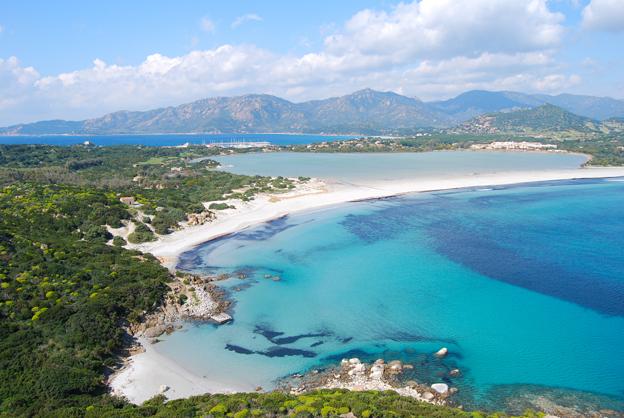Known primarily for its gorgeous beaches and azure waters, Sardinia is the second largest island in Italy and in the Mediterranean.
However, there’s more to Sardinia than the beaches (not that it wouldn’t be enough, beautiful as they are): a magnificent rugged interior with important archeological sites belonging to the ancient Nuragic civilization; up-and-coming cities like Cagliari or smaller towns where to immerse yourself into Sardinia’s simple life; a delicious regional cuisine, from malloreddu pasta to spaghetti with sea urcins, from Fiore Sardo cheese to pane carasau.
Sardinia: The Beaches
There is plenty of choice when it comes to a seaside vacation in Sardinia. The fishing village of Stintino, on Sardinia’s northwestern coast, is a famous resort offering plenty of fun activities, from hiking to scuba diving, from cycling to horseback riding. La Pelosa is Stintino’s most famous beach, standing in front of a 16th-century Aragonese structure, one of the oldest sighting towers in Sardinia. Stintino is located in front of the Natural Park of Asinara Island, home to the Albino donkey and to a variety of habitats, with quite a unique story having been a quarantine location, a prison camp during World War I, and one of the most important Italian high security prisons in the 1970s.

Another popular spot in the north of the island is the Maddalena Archipelago, seven larger islands and approximately 50 islets, set amid turquoise waters, some of the clearest and cleanest in Italy. To protect the fragile environment, the archipelago has been designated a national park. La Maddalena is 20 minutes by ferry from the port of Palau.
Not far is the glitzy Costa Smeralda (Emeral Coast), which has in Porto Cervo its “capital”, a town created and developed in the 1950s and ‘60s by Prince Karim Aga Khan, mesmerized by the blue-green waters of the island’s north-eastern coast. The area soon became a jet-set hideaway, the most luxurious and inaccessible of the Mediterranean. Beyond all the glitz and glamour, the Costa Smeralda is incredibly beautiful, so take time to explore the area, including Palau, Capo d’Orso, and Santa Teresa di Gallura.
Other beaches not to miss include Cala Domestica (south-western coast), Cala Goloritze’ and Cala Mariolu in the Gulf of Orosei (eastern coast), Cala Coticcio on the island of Caprera, famous for having been Giuseppe Garibaldi’s home for 26 years.
Sardinia: Art & Archeology

Unique prehistoric monuments still survive in Sardinia: the “Tombs of the Giants”, the name given by local people and archaeologists to megalithic graves built during the Bronze Age by the Nuragic civilization, found throughout Sardinia; the “Domus de Janas” (house of the witches), pre-Nuragic chamber tombs dating to the early Bronze age; the “nuraghi”, 8,000 ancient megalithic buildings found nowhere else in the world, they are towers-fortresses shaped like truncated cones.
Below are some of the top sites where you can admire them.
Lu Coddu Vecchiu, close to Arzachena, in the north-eastern part of Sardinia. Due to the massive size of some of the stones used, legends developed saying that giants were buried in these tombs. In reality, little is known about the ceremonies and rituals that occurred there.
Tharros, in the province of Oristano, on the western coast of Sardinia. Tharros is the site of a Punic-Roman town founded in the 8th century BC by the Phoenicians on the site of a Bronze Age settlement. The ruins are located on the peninsula of Capo San Marco on the Gulf of Oristano. You can see the remains of the temples, Roman baths, the Castellum Aquae, a Phoenician-Punic tophet, an open-air sacred place, and a neighborhood where artisans worked.
Su Nuraxi, a nuragic archaeological site in Barumini, included in the UNESCO list of World Heritage Sites in 1997 as Su Nuraxi di Barumini. Su Nuraxi is the island’s most visited nuraghe. This settlement consisting of 17th-century BC nuraghi, is considered by archeologists the most impressive representation of the Nuragic civilization. The 1500 BC central tower is possibly the main highlight, but the entire site is extremely fascinating.
Sardinia: The Cities
Cagliari was under the rule of many different civilizations, having been settled for 5,000 years. Its Sardinian name, Casteddu, translates as “castle”. Perhaps the best place where to begin an exploration of this ancient city is right in the narrow lanes of the medieval neighborhood of Castello, with its imposing medieval towers, the Basilica of Santa Croce, the Cathedral of Santa Maria, the Royal Palace and its Bastions overlooking the sea. Large terraces facing the bay offer great views of the city.
Must-see seaside locations close to Cagliari include Santa Margherita di Pula, Chia, Geremeas, Solanas, Villasimius and Costa Rei.
Alghero is one of Sardinia’s most beautiful medieval cities, besides being the main resort on Sardinia’s northwestern coast. Cobbled lanes, Gothic palaces, and small squares can be found in the well-preserved historic center, which end at the marina where yachts are parked. Part of the population of Alghero descends from Catalan conquerors of the end of the Middle Ages, when Sardinia was part of the Kingdom of Aragon. Thus, Catalan is the official language together with Italian and street signs and menus are often written in both languages.

Nearby are many beaches to explore on the beautiful, 90-km Riviera del Corallo, so called because of the numerous red coral formations in the sea, which are used to make elegant jewelry. Do not miss Neptune’s Grotto, and the beaches of Le Bombarde, Porto Ferro and Porticciolo.
And the food? Yes, that is worth discovering too. We will write about it in our Foodie Guide to Sardinia, to be published next week.




